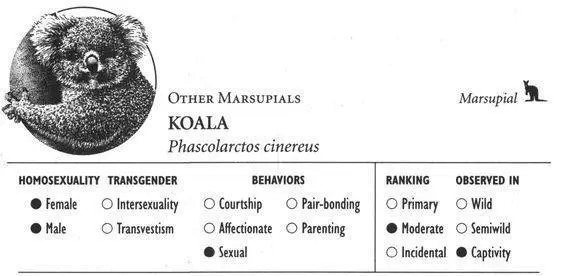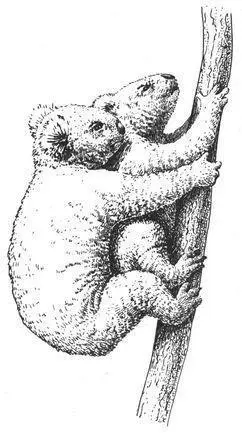Description
Behavioral Expression: Female Rufous Bettongs sometimes court and mount other females, using behavior patterns also found in opposite-sex contexts. A homosexual interaction begins with one female approaching another and then sniffing and nuzzling her genital and pouch openings as well as her anus. The courting female becomes sexually aroused and exhibits a sinuous TAIL-LASHING, in which she moves her tail rapidly from side to side. The other female may initially react with hostility (as do females in heterosexual courtships), lying on her side and kicking with her hind feet while softly growling. As a result, the courting female might perform FOOT-DRUMMING, in which she stands upright on her hind legs near the other female and stamps one foot on the ground in front of her. If the other female calms down, the courting female may mount her by clasping her waist from behind and thrusting against her. Some homosexual interactions in Rufous Bettongs involve adult females courting and mounting juvenile females and vice versa. Sometimes males in the vicinity try to intervene or disrupt females engaging in homosexual behavior, but in other cases they simply ignore the activity. Mountings between females, including pelvic thrusting, also occur in Doria’s and Matschie’s Tree Kangaroos.
Frequency: Homosexual interactions occur fairly frequently in captive Rufous Bettongs: in one study, 3 out of 8 mounts were between females, and homosexual activity was observed a total of 19 times over one month. In Tree Kangaroos same-sex mounting occurs only occasionally.
Orientation: Female Rufous Bettongs that participate in homosexual behavior are probably bisexual, since most mate with males and become successful mothers. Most female Tree Kangaroos that mount other females probably also participate in heterosexual activity, although at least one Matschie’s Tree Kangaroo that participated in same-sex mounts was a nonbreeder.
Nonreproductive and Alternative Heterosexualities
Heterosexual interactions in Rufous Bettongs have a number of nonprocreative aspects. For example, adult males generally make more sexual approaches to juvenile females than to sexually mature adult females. Nonreproductive REVERSE mounts—in which females mount males—occasionally occur in this species, as do attempted mounts by males on females who are not in heat. In the latter case, the female typically responds aggressively, vigorously kicking and growling at him. Although most heterosexual interactions occur between pairs of animals, sometimes two female Rufous Bettongs consort simultaneously with the same male as part of a trio. Among Matschie’s Tree Kangaroos, a form of infanticide known as POUCH-ROBBING has occasionally been observed in captivity, in which females are severely aggressive toward other infants and may actually pull joeys from their mother’s pouch and kill them.
Other Species
Female Tasmanian Rat Kangaroos (Bettongia gaimardi) also engage in homosexual mounting.
Sources
*asterisked references discuss homosexuality/transgender
*Coulson, G. (1989) “Repertoires of Social Behavior in the Macropodoidea.” In G. C. Grigg, P. J. Jarman, and I. D. Hume, eds., Kangaroos, Wallabies, and Rat-Kangaroos, pp. 457–73. Chipping Norton, NSW: Surrey Beatty and Sons.
Dabek, L. (1994) “Reproductive Biology and Behavior of Captive Female Matschie’s Tree Kangaroos, Dendrolagus matschiei.” Ph.D. thesis, University of Washington.
Frederick, H., and C. N. Johnson (1996) “Social Organization in the Rufous Bettong, Aepyprymnus rufescens.” Australian Journal of Zoology 44:9–17.
Ganslosser, U. (1993) “Stages in Formation of Social Relationships—an Experimental Investigation in Kangaroos (Macropodoidea: Mammalia).” Ethology 94:221-47.
*———(1979) “Soziale Kommunikation, Gruppenleben, Spiel- und Jugendverhalten des Doria-Baumkanguruhs (Dendrolagus dorianus Ramsay, 1833) [Social Communication, Group Life, and Play Behavior of Doria’s Tree Kangaroo].” Zeitschrift für Säugetierkunde 44:137–53.
*Ganslosser, U., and C. Fuchs (1988) “Some Quantitative Data on Social Behavior of Rufous Rat-Kangaroos (Aepyprymnus rufescens Gray, 1837 (Mammalia: Potoroidae)) in Captivity.” Zoologischer Anzeiger 220:300–312.
George, G. G. (1977) “Up a Tree with Kangaroos.” Animal Kingdom 80(2):20–24.
*Hutchins, M., G. M. Smith, D. C. Mead, S. Elbin, and J. Steenberg (1991) “Social Behavior of Matschie’s Tree Kangaroo (Dendrolagus matschiei) and Its Implications for Captive Management.” Zoo Biology 10:147–64.
Jarman, P. J. (1991) “Social Behavior and Organization in the Macropodoidea.” Advances in the Study of Behavior 20:1–50.
*Johnson, P. M. (1980) “Observations of the Behavior of the Rufous Rat-Kangaroo, Aepyprymnus rufescens (Gray), in Captivity.” Australian Wildlife Research 7:347–57.

IDENTIFICATION: A bearlike marsupial with woolly brown or gray fur, large black nose, white chest, and long claws. DISTRIBUTION: Eastern and southeastern Australia. HABITAT: Eucalyptus forests. STUDY AREAS: Lone Pine Sanctuary, Brisbane, Australia; San Diego Zoo; subspecies P.c. adustus.
Social Organization
Koalas are largely nocturnal and solitary, although in some populations they tend to live in scattered clusters of two to six females with several males. The mating system is probably promiscuous or polygamous (animals mate with multiple partners), and males take no part in raising their young.
Description
Behavioral Expression: Female Koalas in heat sometimes mount each other in the trees: while one female clings vertically to the trunk, another climbs behind her and reaches around to simultaneously hold on to the tree. She begins to make pelvic thrusts against the other female, while also typically gripping the other female’s neck in her teeth (as does the male during heterosexual mounting). Occasionally one female mounts another from the side (a position sometimes also used by younger males). Usually the mounted female does not display the receptive posture (which involves arching her back while throwing her head back), and homosexual mounts are generally briefer than heterosexual ones. Like male-female copulations, homosexual interactions sometimes involve aggression between the participants: one female may attack the other or pin her to the ground following a mounting. Sometimes two females take turns mounting each other, and homosexual mounting is often interspersed with other signs of intense sexual arousal, including chasing, bellowing, and jerking. BELLOWING is an extraordinary call (also made by males) that has been described as a combination of rasping, growling, wheezing, grunting, rumbling, and braying. It consists of a long series of in-drawn, snorelike breaths alternating with exhalated, belchlike sounds. JERKING is a display resembling the hiccups, in which the female simultaneously jerks her body upward and flicks her head backward repeatedly. Male Koalas also sometimes mount each other, and a few even perform the jerking display like females in heat.
A female Koala mounting another female

Frequency: In captivity, same-sex mounting accounts for 11 percent of all copulatory activity, with the majority of this being mounts between females.
Читать дальше














